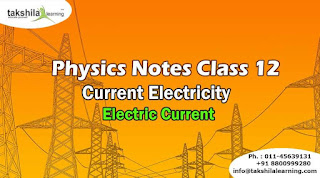CBSE Class 12 Physics Online Notes-Current Electricity
Takshilalearning offer animated courses with live classes as per the CBSE syllabus. Our main objective is to provide quality and result oriented education as well as guidance to the students’ perusing various courses, in order to achieve their goals.
Class 12 Physics: The flow of electric charge through an electric called an electric current. Electric current is basically caused by the flow of electrons or ions. It is denoted by I and its SI unit is ampere. Basically, we can say an electric Current is flow of charge in coulomb per second through any closed circuit. Thus, we have
I=Q/T, where Q is the amount of charge flowing through a circuit in time period T. Ammeter is the device used to measure electric current. Electric current is a scalar quantity though it has magnitude as well as the direction it does not follow the vector law of addition that’s why it is considered as the scalar.
I=Q/T, where Q is the amount of charge flowing through a circuit in time period T. Ammeter is the device used to measure electric current. Electric current is a scalar quantity though it has magnitude as well as the direction it does not follow the vector law of addition that’s why it is considered as the scalar.
OHMS LAW:
According to OHM’s Law, the electric current flowing through any conductor between any two points is directly proportional to the potential difference across those two points, that proportionality constant is resistance and the given equation is
I=V/R
Where ‘I’ is the current flowing through that conductor, V is the potential difference measured across the conductor, R is the resistance of that conductor and their SI units are amperes, Volts and Ohms respectively. The basic point of ohms law is that resistance R is the relation between the current flowing through the circuit and the potential difference across the terminals.
CURRENT DENSITY:
Current density is the measure of the density of an electric current. It is defined as the flow of electric current per cross-sectional area. It is a vector quantity. Its SI unit is amperes per square meter.
I = ∫ Ĵ.dÂ
Where ‘I’ is current in the conductor, Ĵ is the current density and d is the differential cross-sectional area vector. The current density is directly proportional to the to the electric field in that particular medium and relation between the electric field and current density is obtained with the help of conductivity(σ) of the material. Hence, we can say,
Ĵ=σÊ
The reciprocal of conductivity is called as resistivity which is denoted by ρ and the above equation can be written as
Ĵ=Ê/ρ
Ê=Ĵρ
Continue chapter click Class 12 Physics Online Notes-Current Electricity
or more inquires about Physics notes class 12, regular articles of 12th Physics on various topics , 12th Science, NCERT solutions class 12th, CBSE guide, sample papers, latest updates from CBSE Board, Enroll with TakshilaLearning

Comments
Post a Comment
Thank you we will contact ASAP.